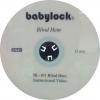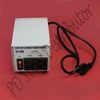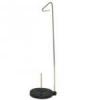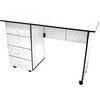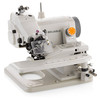Note: FY500 Blindstitcher may have Yamata label on it (California Ship) , or may have Ricoma (Miami ship) from the same Feiyue manufacturer of Yamata and Ricoma Sewing Machines
CM500 (FY500) Portable Blindstitch Sewing Machine Desk model blind stitch Machine is a special sewing machine to form a single thread chain stitch with a single curved needle.The single thread chain stitch hides itself so that you cannot see it from the outside,which make the clothes look more neat,elegant and professionally made.
- Up to 1500 Stitches per Minute Speed
- 110 volts Power
- Swing-down Cylinder Arm
- Swing-Away Work Table
- Skip Stitch Lever
- Knee Lifter Lever
- 3.2 to 6.5mm Stitch Length Adjustment
- 7mm Presser Foot Lift
- Portable
- Blind Stitch Hemmer Machine
- Portable Home Use Sewing Machines for Apparel Tailoring and Alterations only, not the model we recommend for exclusive drapery sewing.
- US Warranty 90 Days labor on defects in materials and workmanship.
- Non-US Warranty: 30 days parts and labor
Blind Hemmer Ending Stitch Techniques I show how I now end my blind hemmer stitches. In the past I always used the old technique of raising the needle to its' highest position and releasing the pressure foot and jerking the fabric back quickly to break the thread. This led to size 10 needles skipping stitches sooner than I thought they should. I contacted the mfg of my machine and they told me to use the technique I show in this video. Since I've gone to it my #10 needles are lasting much longer. :) The machine shown is an Industrial Consew made in Japan back in the 1970s. Kevin Sews Published on Jul 2, 2014
When I pull the stitching out, several stitches unravel along with it. Is there a way to tack the stitches to prevent unraveling?
Jenna, there are several ways of securing a blind hem stitch at the end of a seam. The easiest way is to sew over and beyond the end of a seam, especially if hemming a tubular item like pants. When you sew over previous stitching it helps to lock the stitches in.
Before you remove fabric from the end of the machine feeder, turn the hand wheel clockwise to swing the needle all the way to the left position in the needle channel which will help secure the thread and stitch in place. Then quickly pull or jerk the fabric hem from behind the feeder which will break the thread and tie off the chain stitch so that it will not continue to unravel. It takes some practice because you may have to use the knee lever or hand wheel to position or release the fabric if it is not already at the end of the feeder.
You can also turn the hand wheel counterclockwise at the end of the seam (like reverse stitching but no formation) just to hide the end stitches, or you can manually weave the unraveled thread back into the chainstitch with a seaming needle.
Help!
I am breaking a lot of needles and the tension is getting too tight on its own while stitching and causing the thread to break. I am learning the machine for two weeks. Is it so sensitive too wools, cottons, and fleece that this would make such a major difference in the stitching - breaking needles, breaking thread? Kay
It may not be tension that is causing the problem with your portable blindstitch. If you have broken needles it has probably left some needle burrs in the thread and needle path that need polishing off with fine emory cloth (crocus) before sewing again.
Start with a new LWx6T needle without thread or fabric. Watch the needle as you turn the hand wheel. If there is needle deflection, reduce the penetration dial until there is no needle movement. If there is needle deflection caused by burrs, they must be polished off. Check the looper tip and two arms for any needle burrs and polish off. If there is needle deflection caused by the needle track lifting the needle, lower the track very slightly with the screws on the side of the black metal bracket above the needle.
Finally, Back off on the tension dial and retighten while you are sewing with a light strong thread and light to medium weight fabric, until you get the correct tension without loops. If tension is too tight it will push the thread up so it is not all the way down between the tension discs where it belongs. JMD
John, Received the blind hemmer and used for 1st time yesterday. Works like a champ!!! Thanks so much for helping me out. Deb







